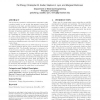373 search results - page 74 / 75 » Learning Arithmetic Circuits |
ISCAS
2006
IEEE
13 years 11 months ago
2006
IEEE
Abstract—We present a silicon neuron that uses shunting inhibition (conductance-based) with a synaptic rise-time to achieve synchrony. Synaptic rise-time promotes synchrony by de...
IWANN
2005
Springer
13 years 10 months ago
2005
Springer
Carbon nanotubes are often seen as the only alternative technology to silicon transistors. While they are the most likely short-term alternative, other longer-term alternatives sho...
SENSYS
2004
ACM
13 years 10 months ago
2004
ACM
The enormous potential for wireless sensor networks to make a positive impact on our society has spawned a great deal of research on the topic, and this research is now producing ...
HICSS
2002
IEEE
13 years 10 months ago
2002
IEEE
Unexpectedly, the widespread availability of very very high speed (Broadband) bandwidth into communities and within large centres has become not only a long-term possibility but a...
DNA
2000
Springer
13 years 9 months ago
2000
Springer
Multicellular organisms create complex patterned structures from identical, unreliable components. Learning how to engineer such robust behavior is important to both an improved un...

